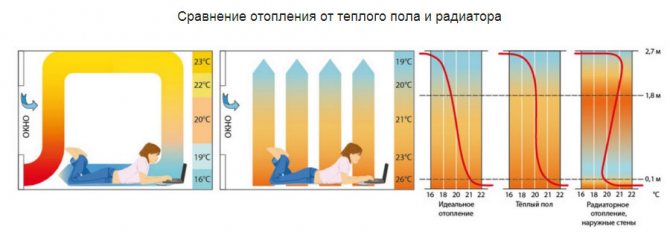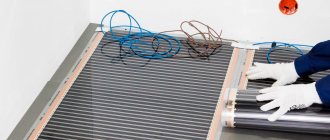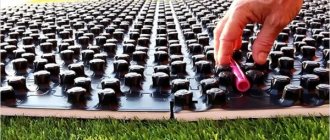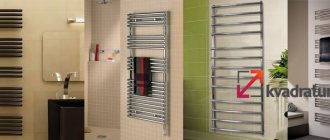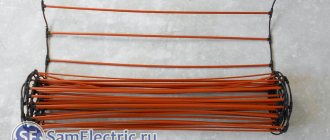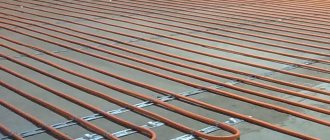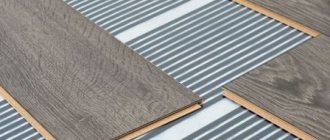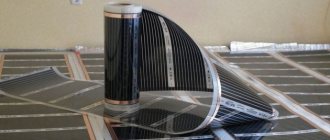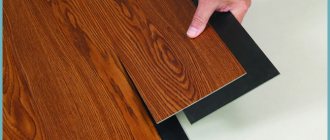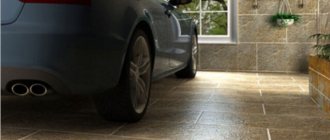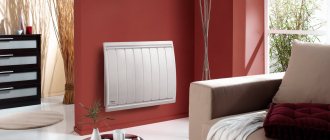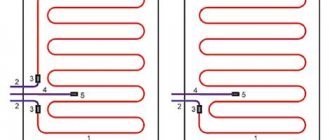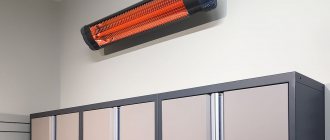The rapid development of heating through floor heating in a room has led to the fact that over the past decade, several varieties of floor heating systems have appeared, each of which has its own characteristic features, advantages and specific operation.
To understand which warm floor is better and choose the most efficient (which will be warmer, better heated) and economical (which consumes less electricity or gas), you need to consider all the existing options and choose the optimal one, taking into account the basic requirements for the system.
Which warm floor is better - species comparison
To simplify the comparison, you need to consider each type of floor and their distinctive features, advantages and disadvantages, and then compare the key indicators in a tabular form.
1 group - water heated floor
In this group, there is only one representative - a warm water floor, the heating element is a system of pipes through which a heat carrier (water) circulates.
Pros: reduction of heating costs by 25% (in comparison with radiator), minimal installation costs, the ability to equip autonomous heating or connect to a central system;
Cons: complexity of design and temperature control, high screed, low maintainability, risk of flooding, the need to approve the project when connecting to the central heating main, the need to equip a boiler room and purchase additional equipment, high operating costs.
Group 2 - electric floor heating
This group is represented by several types of floors, so you need to evaluate which electric heat-insulated floor is better already in the redistribution of subgroups.
Electric floor underlay
Since it is very common for flat versions of electric flooring to be laid directly on top of the finished surface on a prepared concrete base, cables and heating wires can be damaged. To prevent this from happening, a substrate is used for an electric underfloor heating.
Foamed polyethylene sheet, which bears the commercial name penofol, acts as a substrate. Penofol for underfloor heating is available in a variety of options, with a wide variety of thicknesses and textures.
Foil foil foam for underfloor heating is also produced, which has additional characteristics for heat saving, reflecting additional heat into the room. This version of penofol is convenient to use on the first floors of buildings in the case when there is an unheated basement or basement under the ceilings of the first floor.
220-w.ru
Subgroup - electric cable underfloor heating
Cable heat-insulated floor in a coil (in a bay, per meter)
Floor heating cable systems are quite popular among manufacturers. And many of them offer to buy a ready-made kit. Among the leaders in the market are the companies Devi (Denmark), Caleo (South Korea), Teplolux (Russia). The price for a set varies from 10,000 to 37,000 rubles. depending on the heating power, length and type of cable.
The package bundle also affects the cost. There are options that include only cable, regulator and sensor, and some even contain a mounting tool. You can reduce the purchase cost if you complete the system separately. For example, the price of a DEVIflex cable (100 W) is 3,850 rubles / 10 lm, a thermostat with a sensor will cost 6,670 rubles.
Pros: relatively cheap, well suited for use under tiles;
Cons: the complexity of calculation and installation, the height of the room is reduced by 50-100 mm.
We recommend a detailed description - electric underfloor heating device
Cable underfloor heating in mats
It is advisable to choose this option for those who plan to carry out the installation on their own. The price on the example of Devimat ranges from 4,950 to 22,750 rubles. The cost is influenced by the area of the mat, its power, the type of heating cable used.
Pros: thinner cable, simplicity of calculation, it is convenient to lay out the mats (the mesh on which the cable is attached can be cut) and mounted, a constant distance between the cable turns is maintained, there is no need to fill the screed, due to the thickness of the warm floor, the ceiling height is reduced by 10-30 mm ;
Cons: higher cost of mats (25-30% higher compared to the cable system).
Which floor to choose - film or cable
At the very beginning of the article, we asked which warm floor is better, film or cable? So, as usual, it is better to choose one or another type of floor depending on your goals, as well as on the characteristics of the room where you plan to use this type of heating devices.
If it is important for you that the thickness of the floors and flooring does not increase much, when installing a warm floor, choose a film warm floor. If this parameter is insignificant for you, then answer a couple more questions:
1. Is the initial cost of purchasing equipment for installing a warm floor important to you? 2. Do you want to do the installation of the warm floor yourself or will you hire a team of installers - electricians for this. 3. Would you like to fill the warm floor with a screed without fail, or would you just like to put a finishing covering on top of the floor?
Depending on what you choose the answers to the questions, this type of gender is right for you. So let's point by point:
1. Cable underfloor heating is cheaper than film. Therefore, if you want to save money at the purchase stage, choose a cable one. 2. If you want to do the installation of the floor yourself, then choose a film electric floor, it is much easier to install it yourself than a cable one. 3. If you will be pouring the screed, then the cable electric floor is your choice. If you want to put the finishing coating on top as close to the floor as possible, so that the layer is minimal, choose a film floor.
As you can see, choosing a cable or film heat-insulated floor, you are more choosing the features of its purchase and the method of installation, as well as its further operation.
Subgroup - infrared floor heating
Despite the fact that the infrared floor is a kind of electric, it is advisable to place it in a separate group, since the infrared floor has a number of characteristics that are not characteristic of electric cable floors. The key feature of infrared floor heating is that it does not create electromagnetic waves, which is typical of the two previous options. It also has two varieties, which makes it necessary to find out which infrared warm floor is better to choose.
Infrared continuous (film) warm floor
The IR heating system is a flexible heating element placed between two layers of polymer - an infrared heating film for the floor.
Pros: the ability to mount on any surface (floor, walls, ceiling); ease of installation; low cost in comparison with cable, uniform heating of the room, the minimum film thickness makes it possible to dispense with the elimination of floor height differences during installation;
Cons: the need to plan the arrangement of furniture, the complexity of using under tiles, low inertia.
Infrared rod carbon underfloor heating
It is the most advanced underfloor heating system on the market today. It is distinguished by the presence of a carbon heating element made in the form of a rod.The heating rod is made of a composite material, which gives the system the ability to self-regulate, which eliminates overheating and makes it possible not to be limited in choosing a place for installing floor heating. Carbon mats can be installed over the entire floor area, and rearranging furniture or installing household appliances will not cause any inconvenience, unlike a film floor.
Pros: self-regulation. The system monitors the temperature of the floor surface to reduce energy consumption. Moreover, there is no need to use additional devices. The adjustment is due to the fact that an increase in temperature leads to an increase in the distance between the graphite particles that make up the carbon rod, as a result, resistance increases and heating decreases.
Reliability; lack of side effects, in the form of electromagnetic waves, etc., health-improving effect, cost-effectiveness. In terms of heating costs, it is the carbon core floor that is more efficient in operation, due to the reduction in energy consumption. Also, the core heat-insulated floor is distinguished by long-term performance without repair.
Cons: high cost of the kit.
Infrared bar floor
Another type of electric cable mats is infrared rod or carbon fiber. Rod heat-insulated floor is made of carbon rods connected by a polymer conductor. They are sources of infrared radiation. The power of such a mat is from 130 to 160 W per sq. meter, advantages over electric mats:
- When installing rod mats, a screed layer, or rather an adhesive base, only 3 cm thick is required.
- It is not a source of electromagnetic radiation.
- The system regulates the generated heat: when the surface overheats, the carbon rods stop generating it in a limited area. This prevents the system from overheating under furniture or household appliances.
The disadvantages are the high cost of carbon mats, as well as the quick failure of carbon rods: according to the observations of users, there is a high probability of the rods burning at the junction with the conductor.
Which option is better: carbon rod or electric cable? In 70% of cases, craftsmen note the low reliability of carbon heating.
Which warm floor is better - a comparative characteristic
The table summarizes the main parameters for comparative analysis.
| Indicator | Water floor | Electric floor | |||
| Cable | Cable in mats | Film | Rod | ||
| Heating type | Convection | Heat radiation | |||
| Warm-up time, min. | 30-60 | 20-30 | 20-30 | 5-10 | 10-15 |
| Overheating resistance | – | + | + | + | – |
| Add. equipment | boiler | – | – | – | – |
| Installation restrictions | |||||
| - on the balcony / loggia | – | + | + | – | – |
| - in a private house / in the country | + | + | + | + | + |
| - in the apartment | - (permission required) | + | + | + | + |
| Power for 1 sq. M. | Depends on the power of the boiler | 180-220 watts | 180-220 watts | 25-45 watts | 25-50 watts |
| Food / fuel | Gas, solid fuel, electricity | Electricity | |||
| Mounting method | Wet works | Wet works | Wet works | Dry works | Wet works |
| Removable and reusable | – | – | – | + | – |
| Installation restrictions | Cannot be installed under furniture and other low items | ||||
| Installation in a large room | + | (due to the cost of electricity) | |||
| – | – | – | – | ||
| System inertia | high | average | average | high | low |
| Temperature adjustable | – | + | + | + | + |
| Repair-suitability | – | – | – | + | – |
| Demolition of the entire floor is required | Easier due to lack of screed | Dismantling | |||
| Effect on the height of the walls | up to 150 mm | 50-80 mm | 30-50 mm | 5-10 mm | 20-30 mm |
| System weight underfloor heating for 1 sq. squares | 200 Kg | 30 Kg | 30 Kg | 2 Kg | 30 Kg |
| Installation speed | 4-7 days | 1-2 days | 1 day | 1 day | 1 day |
| Time before the start of operation | 7 days | 7 days | 7 days | 1 day | 28 days |
| Initial investment | low | low | average | high | very high |
| Operating costs | high | very high | very high | high | average |
| Cost-effective compared to radiator heating | up to 25% | up to 50% | up to 50% | up to 70% | up to 80% |
| Installation in a room with high humidity (bathroom, sauna) | + | Possibly with reservations | Not recommended | + | |
| Floor Compatibility | |||||
| - natural wood (flooring, parquet) | – | – | – | – | + |
| - laminate | + | + | + | + | + |
| - linoleum | + | + | + | + | + |
| - tiles / porcelain stoneware | + | + | + | + | + |
| - carpet | + | – | – | + | + |
| Radiation | not | electromagnetic | infrared | ||
| Popular / famous brands | – | – | Devi, Teplolux | CalorIQue, Devi, K-Techno -logies (ТМ Caleo) | K-Techno -logies (TM Unimat), Felix (TM Excel) |
| Price, rub / sq.m (average range) | 200-500 | 400-900 | 700-2000 | 1350-1700 | 1500-2685 |
| Estimated service life, years | 10 | 15-20 | 15-20 | up to 50 | up to 50 |
Material prepared for the site www.moydomik.net
What are the advantages of cable systems
Installation of a cable floor is a complex process that requires removing the old screed, installing a layer of thermal insulation and leveling the base, laying the cable and finishing the floor with a cement-sand mixture with a thickness of at least 3-5 centimeters. The advantages of cable systems that are capitally installed in the screed include high power, affordable price, reliability, safety, long service life and the ability of such a floor to accumulate heat, giving it back even after the heating system is turned off.
Such warm floors can be used as the main heating system.
Which floor heating to choose for a private house and apartment?
The selection of a floor heating system is carried out taking into account such factors as:
- the size of the room, in particular floor area and height;
- type of heating. Whether the underfloor heating system will be the main source of heating or an additional one will have a significant impact on its power.
What to look for when choosing a warm floor
- indoor setting... All underfloor heating systems, except for the infrared rod, are very sensitive to overheating, which means that they cannot be mounted under furniture and heavy household appliances. The minimum height is 350 mm. This often leads to the fact that one part of the floor is significantly warmer than the other. Uneven heating (temperature drops) negatively affects the wooden flooring (floor board, solid board, parquet);
- wall height... It should be borne in mind that some underfloor heating systems are mounted exclusively in a screed. This statement is true for a water heated floor, rod and electric with a heating cable or mats. The higher the height of the heating element (pipe diameter or cable section), the thicker the screed will be. If the height of the walls does not allow raising the floor by 70-100 mm, then film warm floors should be considered;
- system maintainability... The screed completely blocks access to the system elements, which creates additional problems in the event of a malfunction, i.e. cannot be repaired quickly. Even identifying the place of failure without dismantling the floor is problematic;
- speed of work... The speed of work is understood as the implementation of all types of work: from design to final surface finishing. Despite the fact that the core floor is installed within a few hours, it is not recommended to turn it on until the screed is completely dry, and some manufacturers (for example, Kaleo) set a limit of 28 days. The water floor is also mounted for a long time, which is associated with the specifics of the piping and also requires the complete solidification of the screed. The best option from the point of view of "operation immediately after installation" would be a film infrared heat-insulated floor.
- type of finish flooring... In many ways, the final choice is determined by the answer to the question, which warm floor is better for tiles, or which warm floor is better for laminate. Indeed, in one case, the use of glue is required, and not all systems are suitable for this, and in the other, it is necessary to take into account the tendency of wood to deform and the presence of harmful substances in the composition of materials (it is possible to release, for example, formaldehyde, when heated).
- profitability... Regarding which warm floor is more economical, users are unanimous and give the palm to rod floors for the economy of operation, and to water floors for the initial investment. But, is it always worth focusing on what is given cheaper? No, it is advisable to compare not by price, but to calculate the average costs for the operational period, and here infrared floors are in the lead.
As you can see, there are many factors that affect the final choice of a warm floor system, the fullest possible consideration of which will help to make the right choice.
Tags:
Floor Warm floor Heating
Cable floors
What is classic cable surface heating? It operates with a special heating cable, filled with a screed, which gives off heat when connected to the network. The cable can be single-core or two-core. When choosing, you should focus on the following parameters:
- A single-core cable is cheaper, but its electromagnetic radiation is higher.
- A two-core cable is easier to connect, electromagnetic radiation is much less, the price is much higher than that of a single-core cable.
The next criterion that you should pay attention to is the power of the additional heating system, it ranges from 150 to 110 W / sq. meter. This indicator directly depends on the quadrature of the room in which the heating is installed. The higher the power, the more it heats up the surface and, accordingly, more electricity is wasted.
Another important point: the width of the cable pitch when installing the system. The cable should be laid in such a way that when the surface warms up, there are no large cold areas left. They will create not only discomfort, but can also damage, warp the floor covering.
An obligatory part of electric cable heating is a thermostat, which will allow not only controlling the temperature, but also gradually heating the surface, which is very important if laminate is used as a floor covering. This option works well with tiled or tiled flooring in bathrooms and kitchens.


